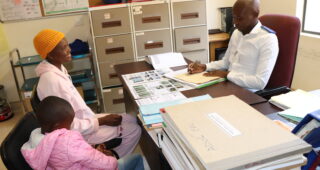Early Infant Diagnosis in Lesotho: Bringing the Test to the Baby
The training room at the Seventh Day Adventist (SDA) Health Centre in the dusty border town of Maputsoe, Lesotho, is filled with women dressed in white. Several of them crowd around a cube-shaped machine, small enough to fit inside a plastic grocery bag, on the tabletop at the front.
A woman pours a few drops of fake blood into a tube inside a cassette-sized canister, then slides the canister into the cube-shaped machine. “Reading cartridge…” reads the screen. A ripple of excitement spreads through the group.
These women aren’t highly trained nurses or lab technicians; they are lay health workers. The machine they are learning to use will test babies for HIV.
Any adult who has had a rapid HIV test knows that the process is simple, at least logistically. Hold out a finger, feel the prick, wait nervously, receive results a few minutes later.
The process is more complicated for newborn babies. Because of maternal antibodies in a newborn’s blood, babies need a more sophisticated virologic test to determine their HIV status, and those tests can’t be performed on the spot. Up until recently the best way to test a baby was through a dried blood spot—or DBS—test, which requires collecting a blood sample from the baby, drying the blood on a test slide, and sending the slide away for analysis in an offsite lab.
In a country like Lesotho, the complicated logistics of processing DBS tests can mean life or death for an HIV-infected baby. The country has notoriously mountainous terrain, with substantial numbers of people living in hard-to-reach areas. There is only one laboratory in the country equipped to process DBS tests, located in the capital city of Maseru. This set of factors means it can take several weeks, even a couple of months, for DBS results to be returned to the clinic of origin. Once the results are in, it can be difficult to track down the affected mother-and-baby pair to deliver the news.
An HIV-infected baby’s first few months are critical, and without immediate treatment the baby has a high probability of death. About 30 percent of HIV-infected babies die before they turn one, and many more become critically ill. The majority die before their fifth birthday.
Babies living with HIV need to be identified and treated as early and quickly as possible – preferably at the point of care (POC) during their first post-natal health visit. The cube-shaped early infant diagnosis (EID) machine at the Maputsoe SDA Health Centre will make this possible.
In partnership with UNITAID, the Elizabeth Glaser Pediatric AIDS Foundation (EGPAF) is dispersing these machines—together with a slightly larger version for bigger health facilities—to a number of pilot sites around Lesotho. The machine tests a baby’s blood for HIV in about 90 minutes as the mother and baby wait—printing the result on a small portable printer. If the baby tests positive, (s)he can be initiated onto treatment right then, before leaving the clinic.
This improvement to the EID process is expected to have a huge impact on the number of babies who test for HIV and actually receive their results, as well as the number of HIV-positive babies who are initiated onto treatment before it’s too late.
By the end of 2018, Lesotho will have 29 EID testing “hub” sites using the POC machines, with an additional 160 “spoke sites” feeding samples to the hub sites. The main goal of the EGPAF-UNITAID project is to reduce the turnaround time for delivering HIV test results to a baby’s caregiver from the current 30-60 days to zero days at hub sites, and seven days at spoke sites.
The project seeks to achieve a 20 percent increase in HIV testing among infants in Lesotho by 2019.
The EID POC machines began arriving in Lesotho in late November, and were formally unveiled to the public on World AIDS Day (December 1) by Lesotho’s Queen ‘Masenate Mohato Seeiso. The machines are already in use at a couple of sites.
The trainees at Maputsoe SDA hospital used fake blood and blood from an adult’s finger while learning to use the POC EID machines. Soon though, they will be pricking babies’ heels and feeding the few drops of blood into the cube-shaped machine on the table. Just like that, children’s lives will change.
Heather Mason, EGPAF
Lesotho
General



